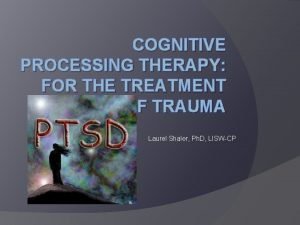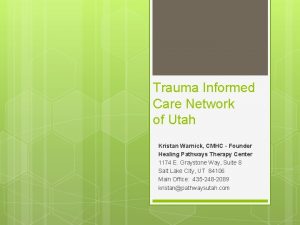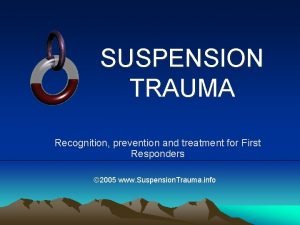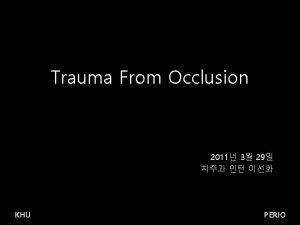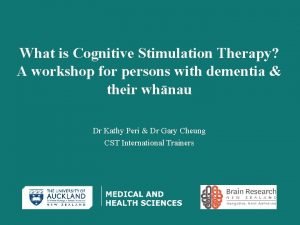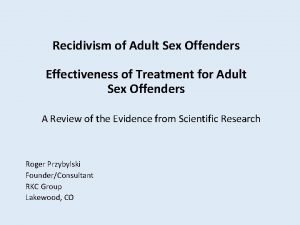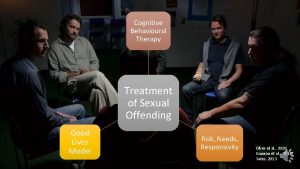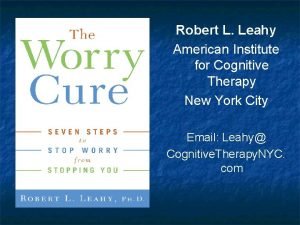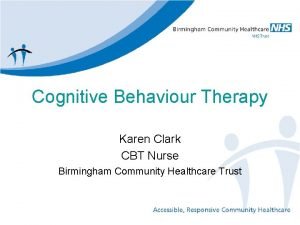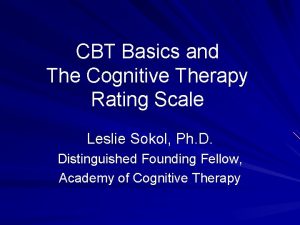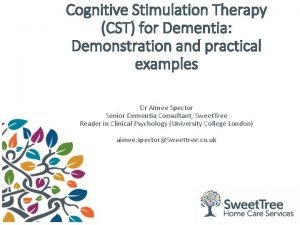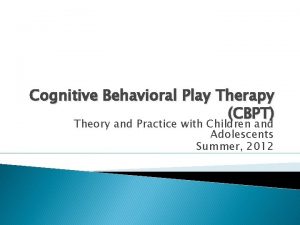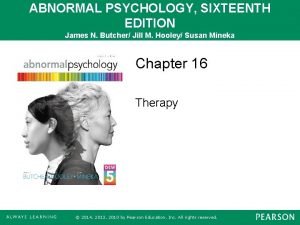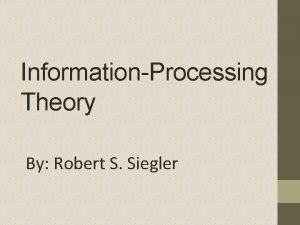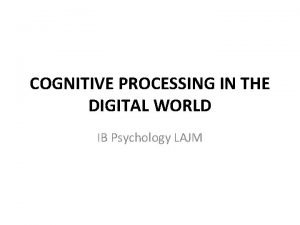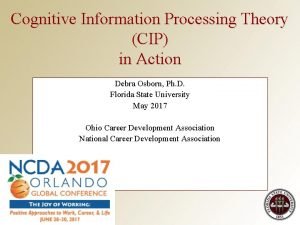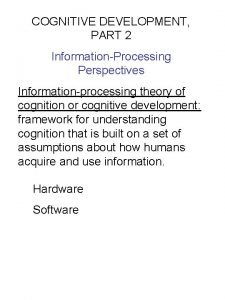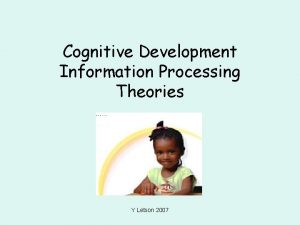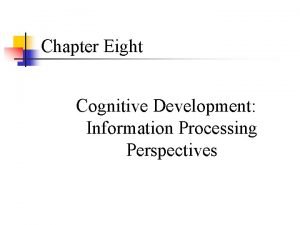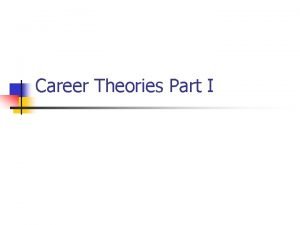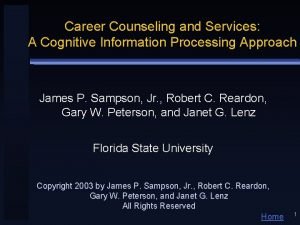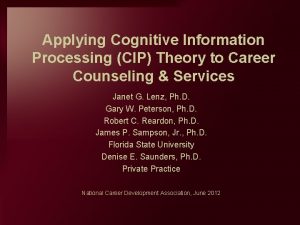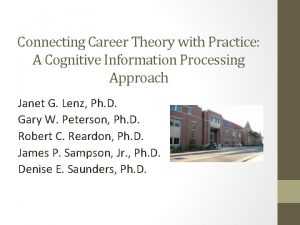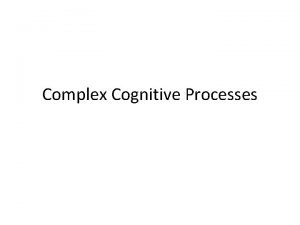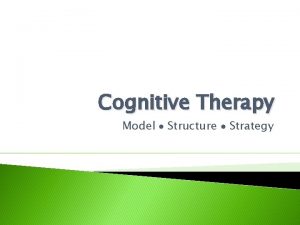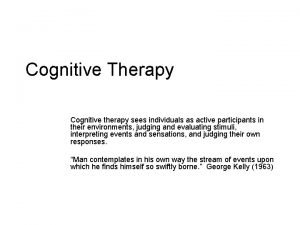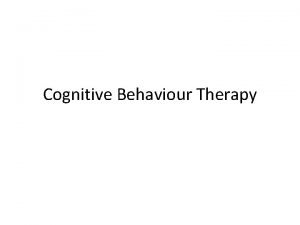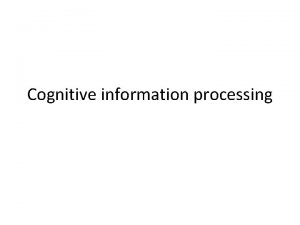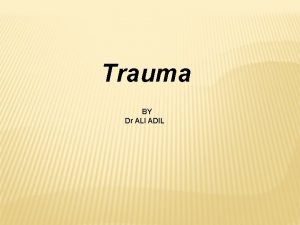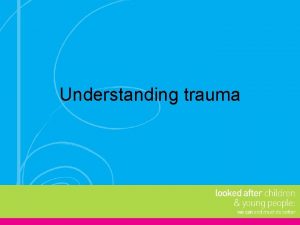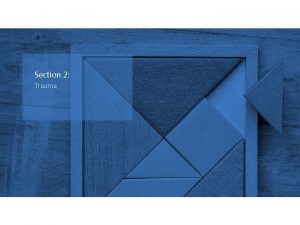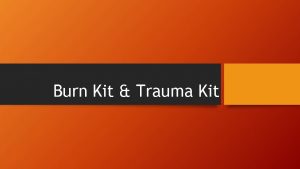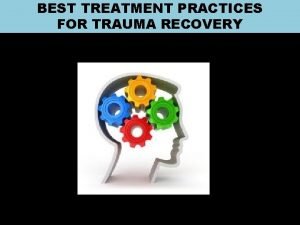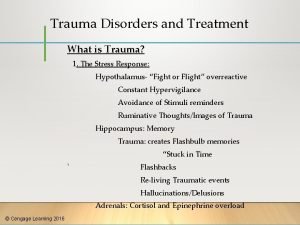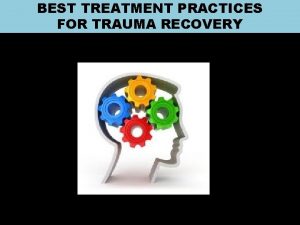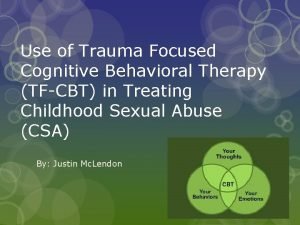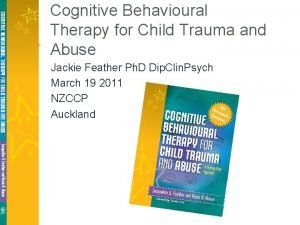COGNITIVE PROCESSING THERAPY FOR THE TREATMENT OF TRAUMA
























































- Slides: 56

COGNITIVE PROCESSING THERAPY: FOR THE TREATMENT OF TRAUMA Laurel Shaler, Ph. D, LISW-CP

Agenda Introduction Posttraumatic Stress Disorder Cognitive Processing Therapy Integration of Faith Questions and Answers

Diagnosis Post-Traumatic Stress Disorder, or PTSD, is a reaction to a traumatic event. According to the DSM-IV, in order to be diagnosed with PTSD, you must have the following symptoms: 1. ) You have been exposed to a traumatic event experienced, witnessed, or were confronted with an event or events that involved actual or threatened death or serious injury, or a threat to the physical integrity of yourself or others)AND your response involved intense fear, helplessness, or horror.

Diagnosis continued 2. ) You re-experience the event in at least one way: Recurrent recollections of the event. Recurrent distressing dreams of the event. Feeling as if the event was recurring, such as in flashbacks. Experience intense distress when exposed to triggers 3. ) You avoid triggers associated with the trauma & numb in three or more of the following ways: Avoid anything associated with the trauma. Can’t recall an important aspect of the trauma. Decreased interest in activities Range of emotions is restricted. Sense of foreshortened future.

Diagnosis Continued 4. ) You have at least 2 increased physical arousal symptoms: Difficulty falling or staying asleep. Irritability or outbursts of anger. Difficulty concentrating. Hypervigilance. Exaggerated startle response. 5. ) All of the symptoms have lasted for more than one month. 6. ) As a result, you are significantly distressed, and your functioning is impaired.

Changes in DSM-V PTSD was moved from “Anxiety Disorders” to “Trauma and stressor-related disorders” “Fear, helplessness, horror” was removed (does not help improve diagnostic accuracy) The three clusters are now four (intrusion, avoidance, negative alterations in cognitions and mood, and alterations in arousal and reactivity)

Changes in DSM-V Self-blame and negative emotional state were added as possible symptoms under negative alterations Reckless/destructive behavior was added to criterion E (under “alterations in arousal”) Subtype “with dissociative symptoms” was added Pre-school subtype (children under 6) was added (http: //www. ptsd. va. gov/professional/pages/ptsd_c hildren_6_and_younger. asp) Reference: NCPTSD

Assessment Tool PTSD Checklist (PCL)~17 item questionnaire on a 5 point Likert scale. Scores of 50 -85 are generally considered significant for PTSD. However, this is self-administered. Issues of minimizing and exaggerating must be considered.

Treatment-Cognitive Processing Therapy CPT was developed by Patricia Resick in the early 1990 s. It combines cognitive therapy and trauma processing (Resick, et al. , 2009). I Conducted via individual or group therapy and is often completed in 12 weekly sessions. Cognitive therapy helps “understand how certain thoughts about your trauma cause your stress and make your symptoms worse” (www. VA. gov/PTSD, 2009). It also helps to identify negative thoughts, replace them, and cope with the upsetting feelings.

Research A recent study found psychotherapy more effective than medication for the treatment of PTSD (Watts, et all 2013). The Dept of VA recommends CBT (in the forms of PE or CPT) and EMDR as psychotherapy treatments for PTSD.

Research continued Four randomized clinical trials have been conducted on CPT. Rape victims (Resick et al. , 2002) ○ CAPS went down over 30 points Child sexual abuse (Chard, 2005) ○ CAPS went down over 40 points Veterans (Monson, 2006) ○ CAPS went down almost 25 points Rape and assault (Resick et al. , 2008) ○ CAPS went down over 40 points

Treatment ( CPT continued) SESSION 1: PTSD Checklist (PCL) Set agenda Describe symptoms of PTSD Client gives examples of symptoms Explain PTSD theory (flight, freeze) Explain Cognitive Theory Assimilation (change memories to fit beliefs) Over-Accommodation (change beliefs about the world) Types of emotions (natural vs. manufactured)

Treatment (CPT continued) Client gives “public version” of most traumatic event Describe the course of therapy and the rationale ~Recognize and modify old thoughts and feelings ~Accept reality of event ~Change beliefs enough to accept ~Feel emotions about event Stuck Points and Log Anticipate avoidance and increase compliance Overview of each session Homework: Impact statement (Why client thinks event happened and how views about self, others, and world have changed as a result).

Treatment (CPT continued) SESSION 2: Client completes PCL Client reads impact statement (If not written, complete orally) Discuss implications of statement Begin to identify stuck points Identify and see connections among events-thoughts-feelings relationship ~Six basic emotions (angry, disgusted, ashamed, sad, scared, and happy) ~Interpretation of events and self-statements (examples of being snubbed on street )

Treatment (CPT continued) Introduce A-B-C Worksheets and fill one out together Homework: A-B-C sheets Check-in with client regarding reaction to session *Optional: Traumatic Bereavement Session. If completing, have client write impact statement related to loss instead of completing A-B-C sheets. Session 2 a will be completed after session 2 and before session 3. After reviewing the impact statement related to bereavement, return to A-B-C sheets.

Treatment (CPT continued)

Treatment (CPT continued)

Treatment (CPT continued) SESSION 3: Client completes PCL Review A-B-C sheets (label thoughts vs. emotions, point out mismatches, look for stuck points) Using Socratic questions, help client generate alternative thoughts and consequent feelings.

Treatment (CPT continued) Gently begin to challenge stuck points Discuss A-B-C worksheet related to trauma Introduce Trauma Account Homework: Full trauma account; Daily reading of trauma account; Daily completion of A-B-C Worksheets

Treatment (CPT continued) SESSION 4: Client completes PCL Client reads Traumatic Account aloud to therapist. Client and therapist discuss reactions to writing and reading account. Identify Stuck Points and challenge Review A-B-C sheets Homework: A-B-C sheets; Rewrite traumatic account with more detail and read daily.

Treatment (CPT continued) SESSION 5: Client completes PCL. Client reads second account of incident. Identify differences between first and second accounts. Any progress? Therapist introduces challenging questions sheet and completes example Homework: Complete “Challenging Questions” sheets daily

Treatment (CPT continued)

Treatment (CPT continued)

Treatment (CPT continued) SESSION 6: Client completed PCL Client and therapist review Challenging Questions Worksheets Assist client in analyzing and confronting stuck points. Therapist introduces “Patterns of Problematic Thinking”: ~Does client have tendency towards specific patterns? ~Describe how patterns become automatic. Homework: ID stuck points and find examples of each pattern. Complete worksheet daily.

Treatment (CPT continued) Patterns of Problematic Thinking: 1. ) Drawing conclusions when evidence is lacking or even contradictory. 2. ) Exaggerating or minimizing the meaning of an event. 3. ) Disregarding important aspects of a situation. 4. ) Oversimplifying events or beliefs as good/bad or right/wrong.

Treatment (CPT continued) 5. ) Over-generalizing from a single incident. 6. ) Mind Reading (assume people are thinking negatively of you when there is no evidence of this). 7. ) Emotional Reasoning (you have a feeling and assume there must be a reason)

Treatment (CPT continued) SESSION 7: Client completes PCL. Client and therapist review Patterns of Problematic Thinking ~Strong tendencies towards specific patterns? ~Discuss how these patterns may have affected reactions to trauma. ~Replace with other, more adaptive, cognitions. Therapist introduces Challenging Beliefs Worksheets: ~Rate strength of belief and emotion; Use Challenging Questions and Patterns of Problematic Thinking; Generate new statements

Treatment (CPT continued)

Treatment (CPT Continued) Therapist introduces Safety module. ~Self: Belief that you can protect yourself from harm and have some control over events. Symptoms of negative self-safety include anxiety, irritability, started responses, and intense fears. ~Others: Belief about dangerousness of other people and of expectancies about the intent of others to cause harm, injury, or loss. (Avoidance and Social W/D) ~ Homework: Read Safety module and complete worksheets on stuck points using at least one on safety.

Treatment (CPT continued) SESSION 8: Clients completes PCL. Client and therapist review Challenging Beliefs worksheets. Client and therapist discuss Safety issues. Therapist introduces Trust module (see next slide) Homework: Read trust module and complete worksheets on stuck points using at least one on trust.

Treatment (CPT Continued) Trust Module: Self: Belief that one can trust or rely on one’s own perceptions. Symptoms of negative self-trust beliefs including anxiety, confusion, and self-doubt. Others: Belief that promises of other people can be relied on with regards to future behavior. A person needs to learn a healthy balance of trust and mistrust and when each is appropriate. Symptoms of negative others-trust includes disappointment in others, fear of relationships and betrayal, anger at betrayers, and fleeing.

Treatment (CPT continued) SESSION 9: Client completes PCL Client and therapist review homework on trust issues and other completed worksheets. Discuss how trust falls on a continuum (star diagram). Therapist introduces power/control module.

Treatment (CPT continued) Self: Belief that you can solve problems and meet challenges. Symptoms include numbing, avoidance of feelings, hopelessness and depression. Others: Belief that you can control future outcomes in relationships and that you have some power. Symptoms include passivity, submissiveness, and inability to maintain relationships. Homework: Read power/control module and complete worksheets on stuck points using at least one on power/control.

Treatment (CPT continued) SESSION 10: Client completes PCL. Client and therapist review power/control issues and Challenging Beliefs Worksheets. Help client gain a balanced view of power/control ~Ways of Giving Power Positive: Being altruistic and helping others Negative: Basing actions solely on others. Always placing needs of others above own. ~Ways of Taking Power Positive: Being assertive, Setting boundaries, and Being honest with others. Negative: Giving ultimatums, Testing limits, Aggressive

Treatment (CPT Continued) Therapist introduces esteem module. Self: Belief in own worth. Examples of negative selfesteem beliefs include “I am bad”, “I am damaged”, “I am worthless”. Symptoms include depression, guilt, and shame. Others: Beliefs about how much you value other people. Negative beliefs include thinking people are bad, evil, uncaring, indifferent, etc. Symptoms include anger, bitterness, isolation, etc. Homework: Read esteem module and complete worksheets on stuck points using at least one on esteem. Client also practices giving compliments and doing nice things for self.

Treatment (CPT continued) SESSION 11: Client completes PCL and discuss compliment and pleasant activities. Client and therapist review esteem issues and Challenging Beliefs Worksheets ~Does client believe s/he is permanently damaged or is s/he a perfectionist? Therapist introduces intimacy module. ~Self: Ability to soothe and calm self. Symptoms associated with negative self-intimacy beliefs include inability to comfort and soothe self, fear of being alone, external sources of comfort, needy.

Treatment (CPT Continued) Others: Capacity to be intimately connected with others. Symptoms associated with negative others-intimacy beliefs include loneliness, isolation, and failure to connect with others. Homework: Read intimacy module and complete worksheets on stuck points using at least one on intimacy. Client also writes new impact statement.

Treatment (CPT continued) SESSION 12: Client completes PCL. Client and therapist review intimacy worksheets. Client reads new impact statement. Client and therapist review course of therapy and skills learned. Veteran is given blank copies of worksheets for continued use. *A four week follow-up is scheduled. *

Follow-Up At 12 th session, schedule a 4 week follow-up. Have client complete PCL at 4 week follow-up. Determine if there is anything else the client needs to work on. Congratulate client on completing CPT and encourage client to continue using learned skills.

CPT-C Cognitive Processing Therapy-Cognitive (CPTC) is conducted without the written account of trauma. Only A-B-C sheets are assigned for practice during Sessions 2 and 3. Sessions 4 -7 are in a slightly different order: ~Session 4: Identification of Stuck Points ~Session 5: Challenging Questions ~Session 6: Patterns of Problematic Thinking ~Session 7: Challenging Beliefs

Group CPT/CPT-C Group can be facilitated using CPT or CPTCognitive. Information session and letter of commitment can be helpful. Eight-Ten members, 90 minutes long. Group members do not read their impact statements or trauma accounts aloud in group.

Group CPT/CPT-C Group can be conducted with one or two facilitators. If one facilitator, a break can be taken in the middle of group to allow time to review practice assignments. Pros: efficient, group dynamics, opportunity for trust building, helps with avoidance Cons: difficult to stay on task, potential negative dynamics (ex. Monopolizing client)

Christian Integration Spirituality as a whole: A 2008 study found large effect sizes for “reducing PTSD symptom severity, psychological distress, and increasing quality of life” when studying “mantram repetition” (repeating a sacred word/phrase through the day). Small group of 29 of who completed the study. (Bormann, Thorp, Wetherell, & Goishan in PTSD Research Quarterly, 2012).

Christian Integration A 2011 meta-analysis of 46 studies (N = 3, 290) compared psychological and spiritual outcomes to: 1. ) A control condition (such as only assess. ) 2. ) An alternate treatment (non-religious) 3. ) A dismantling design (example: CBT vs CBT with religious accommodation Reference: Worthington, E. , Jr. , Hook, J. , Davis, D. , & Mc. Daniel, M. (2011). Religion and spirituality. Journal of Clinical Psychology: In Session, 67(2), 204 -214.

Christian Integration Results: Those in religiously accommodated psychotherapies showed “greater improvement than those in alternate secular psychotherapies on psychological (d =. 26) and spiritual (d =. 41) outcomes. ” On dismantling, psychological outcome was the same but spiritual outcomes showed greater improvement (d =. 33). Reference: Worthington, E. , Jr. , Hook, J. , Davis, D. , & Mc. Daniel, M. (2011). Religion and spirituality. Journal of Clinical Psychology: In Session, 67(2), 204 -214.

Christian Integration Weaknesses of research: We don’t know that theology of therapist matched that of the client. Amount of spiritual accommodation was variable. Research was mostly facilitated with theologically conservative clients. Most research was on CBT (a pro for CPT!) Reference: Worthington, E. , Jr. , Hook, J. , Davis, D. , & Mc. Daniel, M. (2011). Religion and spirituality. Journal of Clinical Psychology: In Session, 67(2), 204 -214.

Christian Integration What is “Christian accommodation”? Being a Christian therapist? Praying for client outside of treatment? Praying for client in treatment? Treatment consistent with Christian values? Treatment that uses Scripture? Reading Bible in session? Answering theological questions? (Where was God when my buddy was killed? ) Helping the client find a church? Helping clients understand God? Reference: Worthington, E. , Jr. , Hook, J. , Davis, D. , & Mc. Daniel, M. (2011). Religion and spirituality. Journal of Clinical Psychology: In Session, 67(2), 204 -214.

Christian Integration THERE IS NO “CORRECT” ANSWER.

Christian Integration Recommendations: Assess…. ○ Know your clients (faith, concerns, etc) ○ What and how much does the client want? ○ Does religious accommodation fit your client? ○ Does it fit the treatment that is most appropriate for client? ○ Does your client improve? (PCL and spiritual questionnaire? ) Show it works. Reference: Worthington, E. , Jr. , Hook, J. , Davis, D. , & Mc. Daniel, M. (2011). Religion and spirituality. Journal of Clinical Psychology: In Session, 67(2), 204 -214.

Christian Integration and CPT Because CPT deals with beliefs, it is a good fit for those that have upsetting thoughts and feelings related to faith. For example, a client might say: A: My best friend was killed in front of me. B: God doesn’t care about me or anyone in my world. C: I feel angry.

Christian Integration and CPT The client then explores that belief for him or herself using the same method as all other beliefs. The client comes to his or her own conclusion about whether or not this is a realistic or unrealistic belief.

Christian Therapists As Christian therapists, we should model for our clients. We can rely on God for wisdom to guide us in our sessions. Dr. Siang-Yang Tan (Fuller Seminary)has written much about CBT and Christian integration.

Other resources https: //cpt. musc. edu/index/ www. ncptsd. gov PPT can be found at: www. drlaurelshaler. com

References American Psychological Association. (2000). Diagnostic and statistical manual of mental disorders (4 th ed. , text revision). Washington, DC: Author. Bormann, J. E. , Thorp, S. , Wetherell, J. L. , & Golshan, S. (2008). A spiritually based group intervention for combat Veterans with posttraumatic stress disorder. Journal of Holistic Nursing, 26, 109 -116. Bormann, Thorp, Wetherell, & Goishan in PTSD Research Quarterly, 2012 Center for study of traumatic stress (2009). Retrieved fromhttp: //www. centerforthestudyoftraumaticstress. org/csts_items/CSTS_evi dence_based_management_PTSD. pdf. Department of Veterans Affairs (2009). Retrieved from www. VA. gov/PTSD. Figley, C. R. (2006). Assessment and treatment of post-traumatic stress disorder. Tallahassee, FL: Figley Institute. Litz, B. , Stein, N. , Delaney, E. , Lebowitz, L. , Nash, W. , Silva, C. , & Maguen, S. (2009). Moral injury and moral repair in war veterans: A preliminary model and intervention strategy. Clinical Psychology Review, 29(8), 695 -706. National Center for PTSD (2012). PTSD Research Quarterly, 23, (2).

References (continued) Resick, A. R. , & Calhoun, K. S. (2001). Posttraumatic stress disorder. In Barlow, D. H. (Ed. ), Clinical handbook of psychological disorders (pp. 60 -113). New York: The Guilford Press. Resick, P. , Monson, C. , Chard, K. (2008). Cognitive processing therapist group manual: Veteran/military version. Washington, DC: Department of Veterans’ Affairs. Resick, P. , Monson, C. , Chard, K. (2008). Cognitive processing therapy veteran/military version: Therapist’s manual. Washington, DC: Department of Veterans’ Affairs. Resick, P. , Monson, C. , Chard, K. (2008). Cognitive processing therapy veteran/military version: Therapist and patient materials manual. Washington, DC: Department of Veterans’ Affairs. Resick, P. , Monson, C. & Chard, K. (2008). Workshop: Cognitive Processing Therapy (PPT). National Center for PTSD. Resick, P. & Schnicke, M. (1993). Cognitive Processing Therapy for Rape Victims: A Treatment Manual. Sage Publications

References (continued) Rothbaum, B. , Kearns, M. , Price, M. , Malcoun, E. , Davis, M. , Ressler, K. , …Houry, D. (2012). Early intervention may prevent the development of posttraumatic stress disorder: A randomized pilot civilian study with modified prolonged exposure. Biological Psychiatry. Schnurr, P. et al. (2007). Cognitive behavioral therapy for post-traumatic stress disorder in women. Journal of american medical association, 297(8), 820 -830. Watts, B. V. , Schnurr, P. P. , Mayo, L. , Young-Xu, Y. , Weeks, W. B. , & Friedman, M. J. (2013). Meta-analysis of the efficacy of treatments for posttraumatic stress disorder. Journal of Clinical Psychiatry, 74, e 541 - e 550. PILOTS ID: 41029 Williams, M. & Poijula, S. (2002). The PTSD Workbook. New Harbinger Publications: Oakland, CA. Worthington, E. , Jr. , Hook, J. , Davis, D. , & Mc. Daniel, M. (2011). Religion and spirituality. Journal of Clinical Psychology: In Session, 67(2), 204 -214.
 Ptsd a-b-c worksheets examples
Ptsd a-b-c worksheets examples Trauma awareness and treatment center utah
Trauma awareness and treatment center utah How to treat suspension trauma
How to treat suspension trauma Trauma from occlusion treatment
Trauma from occlusion treatment Cognitive and non cognitive religious language
Cognitive and non cognitive religious language Cognitive stimulation therapy training
Cognitive stimulation therapy training For adult sex
For adult sex Cognitive behavioral therapy for sex offenders
Cognitive behavioral therapy for sex offenders American institute for cognitive therapy
American institute for cognitive therapy Cognitive behavioural therapy birmingham
Cognitive behavioural therapy birmingham Cognitive therapy rating scale
Cognitive therapy rating scale Cognitive stimulation therapy training course
Cognitive stimulation therapy training course Cbpt training
Cbpt training Cognitive therapy borrows many techniques from
Cognitive therapy borrows many techniques from Counterconditioning psychology
Counterconditioning psychology Reality therapy techniques
Reality therapy techniques Both psychoanalysis and humanistic therapy stress
Both psychoanalysis and humanistic therapy stress Bioness bits cost
Bioness bits cost Psychoanalytic therapy is to as humanistic therapy is to
Psychoanalytic therapy is to as humanistic therapy is to Siegler information processing theory
Siegler information processing theory Cognitive processing in the digital world
Cognitive processing in the digital world Cip model
Cip model Information processing theory of cognitive development
Information processing theory of cognitive development Information processing theory of cognitive development
Information processing theory of cognitive development Cognitive information processing theory
Cognitive information processing theory Cognitive information processing
Cognitive information processing Pyramid of information processing
Pyramid of information processing Cip model
Cip model Cip theory career development
Cip theory career development How do we learn complex processes
How do we learn complex processes Top down processing
Top down processing Gloria suarez
Gloria suarez Top-down processing vs bottom-up processing
Top-down processing vs bottom-up processing Unsharp masking matlab
Unsharp masking matlab Primary, secondary and tertiary food processing
Primary, secondary and tertiary food processing Point processing in digital image processing
Point processing in digital image processing Histogram processing in digital image processing
Histogram processing in digital image processing Parallel processing vs concurrent processing
Parallel processing vs concurrent processing Nonlinear image processing
Nonlinear image processing Point processing in image processing
Point processing in image processing Digital image processing
Digital image processing Bottom down processing
Bottom down processing Batch processing vs interactive processing
Batch processing vs interactive processing Formuö
Formuö Typiska drag för en novell
Typiska drag för en novell Nationell inriktning för artificiell intelligens
Nationell inriktning för artificiell intelligens Ekologiskt fotavtryck
Ekologiskt fotavtryck Shingelfrisyren
Shingelfrisyren En lathund för arbete med kontinuitetshantering
En lathund för arbete med kontinuitetshantering Adressändring ideell förening
Adressändring ideell förening Tidböcker
Tidböcker Anatomi organ reproduksi
Anatomi organ reproduksi Vad är densitet
Vad är densitet Datorkunskap för nybörjare
Datorkunskap för nybörjare Tack för att ni lyssnade bild
Tack för att ni lyssnade bild Debattartikel struktur
Debattartikel struktur Magnetsjukhus
Magnetsjukhus
